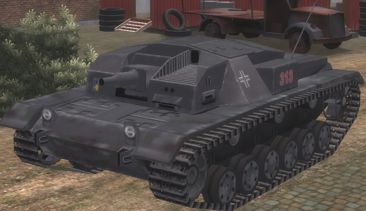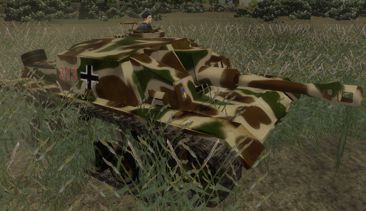StuG
StuG III Ausf. B
History
| 400px | |
| Main Gun Optics | |
| Specifications | |
| Designation | Sfl.ZF 1 |
| Magnification | 5x |
| Field of View | 8° |
The Sturmgeschütz (Assault Gun; StuG) III originated from an initial proposal that Colonel Erich von Manstein submitted to General Beck in 1935 in which he suggested that Sturmartillerie (Assault Artillery) units should perform direct-fire support for infantry divisions. To that end, on June 15, 1936, Daimler-Benz AG received an order to develop an armoured infantry support vehicle capable of mounting a 7,5cm (2.95in) artillery piece. The gun was to have a limited traverse of a minimum of 25 degrees and be mounted in a fully enclosed superstructure that provided overhead protection for the crew. The height of the vehicle was not to exceed that of the average man.
Daimler-Benz AG used the chassis and running gear of its recently designed PzKpfw III medium tank as a basis for the new vehicle. Prototype manufacture was passed over to Alkett, which in 1937 produced five examples of the experimental O-series StuG based upon the PzKpfw III Ausf. B. These prototypes featured a mild-steel superstructure and Krupp’s short-barreled 7,5cm Sturmkanone(Assault Cannon; Stu.K.) 37 L / 24.
In January 1940, the first production StuG III Ausf. A, based upon the excellent PzKpfw III Ausf. F with improved suspension and transmission, was accepted into service. Although based upon the PzKpfw III Ausf. F, the StuG carried thicker front and rear armour and lacked escape hatches on the hull sides. The 7,5cm Stu.K. 37 L / 24 was mounted offset to the right in a sloped superstructure. The driver peered through a twin periscope device and pivoting visor while the gunner, besides having an artillery-type periscopic sight for aiming the gun, could see through a direct-vision port in the upper left superstructure. The commander had access to a scissors periscope that rose through the front half of his access hatch. Only 30 Ausf. A were produced.
The Ausf. B was introduced during June 1940. It featured improved engine ignition and a synchromesh transmission replaced the pre-selective transmission of the Ausf. A. Some later Ausf Bs introduced a new six-spoke drive sprocket and an eight-spoke idler for use with wider 40cm (15.75in) tracks. After the Ausf. B, new StuG models that incorporated minor layout and chassis changes appeared at timely intervals until the Ausf. E was introduced during the autumn of 1941. The Ausf. E was the last model to sport the short-barreled 7,5cm and was the first to include a machine gun.
The production run of 30 Ausf. As had equipped Sturmartillerie Batteries (Assault Artillery Batteries) numbered 640, 659, 660, 665, and the 1. SS-Panzer-Division Leibstandarte Adolf Hitler (SS Armoured Division-Adolf Hitler Personal Guard; often called the LSSAH). Each unit controlled six StuGs. A StuG crew consisted of a commander called a Geschützführer (gun leader), gunner, loader, and driver. Officially artillerymen, they wore the field-grey uniforms of that branch and not the black of the Panzerbesatzungen (tank crews). The StuGs performed well in Holland, Belgium and France, destroying fixed fortifications, anti-tank guns, and machine gun nests.
In August 1940, Sturmartillerie Batteries were organised into Abteilungen (battalions). Each Sturmartillerie Abteilung consisted of three batteries of six guns, 18 StuGs total. In early 1941, the battalions were broken down into their component batteries, renamed Sturmgeschütz Batteries. In April 1941, the complement of StuGs in each battery increased to seven.
Despite constant reminders not to use it as a tank, the StuG was constantly forced into that role by the fluidity of the modern battlefield. Carrying a number of HEAT rounds permit it some effective anti-tank ability at shorter ranges. It performed rather well, despite an aiming system more suited to long-range artillery. Its short cannon was adequate for close-in work but suffered from dispersion at range. The fixed-forward gun mount could be traversed over a firing arc of roughly 22.5 degrees. Its lack of a machine gun of any sort made it particularly vulnerable to enemy infantry.
Game Play
The StuG III Ausf. B is extremely well armored frontally but suffers from some glaring weaknesses. The lack of a turret restricts the gunner to a narrow field of view, about 22.5 degrees. This places greater reliance on the commander – the moment he’s dead, you lose all ability to view to the sides or rear of the tank. Don’t risk being unbuttoned any more than necessary.
Good StuG players are tough opponents because they have learned the hard way how to be effective. The gunsight is both a weakness and a strength in anti-tank combat. Deploying it means opening up the viewport and allowing enemy rifleman to put bullets inside the StuG. Even worse, the poorly designed view port lies at the end of a funnel that acts as a shot trap for incoming rounds. On the other hand, the optical performance of the sight is magnificent.
The StuG lacks a machine gun. Unless you can drive over an enemy anti-tank infantry or hit him with your stubby gun, there’s nothing you can do but drive away. The StuG is more vulnerable to infantry attack than many tankers are used to accepting.
The Commander (crew position 2) has a rangefinder (key “R” to operate) in binocular view. Crew position 3 may not look through the gunsight until it is deployed (D key) which opens the viewport and places the firing sight in the view slit.
The StuG III Ausf. B can contribute fairly effectively as a mobile artillery piece for shelling targets from range. Keep in mind that AP, HEAT, and HE rounds all have different ballistics, and the StuG gunsight does not differentiate between them. You will need to practice to know what flights to expect from various rounds (typically, HE/HEAT don’t fly as far or as flat as AP rounds do). It’s not a bad idea to range a few different targets in practice offline before you have to engage enemy units in the online battlefield environment. You can also practice with the similar gun on the PzKpfw IV Ausf. D.
StuG III Ausf. G
History
| 400px | |
| Main Gun Optics | |
| Specifications | |
| Designation | Sfl.ZF 1a |
| Magnification | 5x |
| Field of View | 8° |
In March 1942, the StuG III Ausf. F entered production. This vehicle was meant not only as an assault gun but also as a mobile tank destroyer that could dispatch the newer and heavier Russian T-34s and KV-1s that the Wehrmacht was encountering in increasing numbers. To meet this threat, early Ausf. Fs were equipped with the 7,5cm Stu.K.40 L / 43. The heavier cannon necessitated a redesign of the gun mantlet to accommodate the larger recoil mechanism.
The last 31 vehicles of the Ausf. F designation received an even longer gun, the 7,5cm Stu.K.40 L / 48. When Ausf. F production shifted to use the PzKpfw III Ausf. J and L chassis, the type’s designation changed from the Ausf. F to the Ausf. F/8. All Ausf. F/8s were armed with the 7,5cm Stu.K.40 L / 48. The rear deck was extended and ventilation improved in the F/8 as well. An additional 30 mm (1.18 in) of armour was bolted to the front of the hull and superstructure and rear armour thickness was increased to 50 mm (1.97 in).
In early 1943, the StuG III Ausf. G appeared, based on the chassis of the PzKpfw III Ausf. M. The Ausf. G would be manufactured in far greater numbers than all other variants of StuG combined. Among other chassis enhancements, a cupola with periscopes was added for the commander, a shield for the machine-gun was installed in front of the loader’s hatch, and armour plate was added to protect the front of both panniers. Side armour became slanted. In February 1944, the last of the StuG line was upgraded to a Saukopf (sow’s head) gun mantlet, followed by a coaxial machine gun. Over the next few months, the Ausf. G also gained a Nahverteidigungswaffe (Close Combat Defense Weapon) system and a remotely controlled machine gun on the superstructure roof. Most were equipped with Schürzen (skirts) to protect against hollow-charged weapons, and a Zimmerit coating to fend off hand-placed magnetic mines.
Most of the StuG IIIs with long-barreled weapons (sometimes called StuG 40s, after their StuK 40 guns) saw service primarily in a defensive anti-tank role.
The importance of the StuG III cannot be overerestimated. It was manufactured in far greater numbers than any other German armoured fighting vehicle and was easier, cheaper, and less time-consuming to manufacture than any turreted tank. One StuG III Ausf. G was estimated to cost 82,500 Reichmarks – one quarter the cost of a single Königstiger (King Tiger). As the war turned into a much more defensive affair for the Axis forces, these highly effective ambush-style tank hunters became a valuable resource, probably claiming more kills than all German turreted tanks would by wars end.
Game Play
The utility and value of the StuG III Ausf. G depends a great deal on the tactical situation. If on the defensive, the Ausf. G is probably the best ambusher of the game. Its low profile, camouflage, and the undeniable lethality of the gun mean that if it gets the first shot, it generally wins. If the enemy spots you, they will easily identify you as the dangerous StuG III Ausf. G due to the distinctive camouflage and shape. Allied opponents will hunt you with great dedication because you represent such an enormous threat to their armour. As is usual for a turretless AFV, situational awareness is a problem, and the small amount of ammunition you carry limit your ability to sustain a gun duel or hold a position in the face of a persistent attack. On the plus side, even if you are identified, your thick frontal armor will protect you as you withdraw from a fight.
Lacking a machine gun for defense against infantry, the StuG is at their mercy if they get close. If you spot enemy infantry around you, pull out. It's always a good idea to have your own dedicated infantry work with you – don’t stick around if you detect enemy infantry in your immediate area otherwise.
The StuG's HE rounds tend to fall shorter than AP rounds, especially at longer ranges. The PzKpfw IV Ausf. G uses almost the same gun, but the StuG lacks the tank gunsight's AP/HE ranging system. If you’re going to be using a StuG III Ausf. G a lot, it’s worthwhile to jump into a PzKfw IV G offline and jot down some corresponding ranges for reference when shooting the StuG gun.
Crew 1 (driver) has a non-zoom view slit to his left. Crew 2 (commander) may use the numpad “0” or “Ins” key to look through periscopes of his cupola without exposing himself outside the tank. He may not use his included rangefinder unless he unbuttons, however. Crew 3 must still deploy a sight to aim the gun, but in this case it peeks out of a small roof hole instead of opening the shot-trap view slit of its earlier variant.

